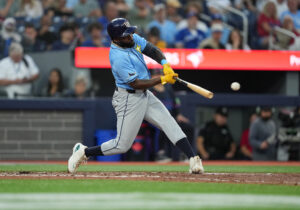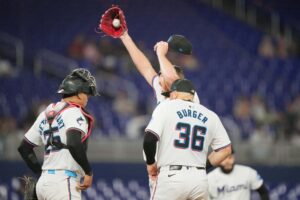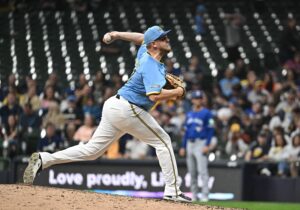Tyler Chatwood Contract Adds Potential
It may not be a blockbuster move, but the Toronto Blue Jays took a step forward as they signed Tyler Chatwood.
The 31-year old veteran will be teaming up with the Blue Jays on a one-year contract worth $3 million. That also includes a potential for $2.5 million in incentives. That will be a significant pay cut after earning $13 million across 2020 alone.
The deal comes after a season to forget for Chatwood who faltered heavily while as a member with the Chicago Cubs. The right-handed pitcher began with the Cubs back in 2018 as a starter. Control issues pushed him back to the bullpen in 2019 before a slight resurgence to a starter in 2020. Chatwood sported a record of 2-2 with an ERA of 5.30 complete with 25 strikeouts in his farewell season with the Cubs. Overall, his time in the major leagues hasn’t given many teams a whole lot of interest with a 51-57 record and a 4.40 ERA. That’s across stints with the Los Angeles Angels in 2011, the Colorado Rockies from 2012-14 and 2016-17, and the Cubs from 2018-20.
Still, the Blue Jays have added a cost-effective pitcher with plenty of upside.
Potential, Potential, Potential
While Chatwood has shown flashes of brilliance throughout his career, he’s always seemed to have more potential success than actual success. The issue of locking down the strike zone came up a lot as the former second-round draft pick struggled yet ranked in the 96th percentile, according to Baseball Savant, in both curveball and fastball spin rate across 2020. That helped to push Chatwood into the 77th percentile in strike percentage. Across the past two seasons, opposing batters barrelled up 11 balls out of 1,618 total pitches.
In 2019 alone, Chatwood ranked among the top 2.9% of all pitchers in the league in percentage of barrels met. That was perhaps his best season. Some numbers made Chatwood appear like a borderline All-Star. This is seen by batters hitting .176 against him across 184 plate appearances. Advanced metrics and analytics were practically in love with Chatwood, but again mainly on potential.
WHIF Rate
Prior to his arrival to the north side of Chicago, Chatwood was looked at for solid control of the strike zone. That’s not what the Cubs received in 2018. He sported a career-high 95 walks the most among all National League pitchers. Just when things started to be picking back up for the veteran, the bottom seemed to fall out from under him. Despite a rather strong 2019 campaign, the inconsistency issues halted any further progress. From 2019 to 2020, Chatwood’s WHIF percentage dropped on all but one of his five pitches. What really has coaches pulling out their hair is that Chatwood even posted one of the highest opponent WHIF percentage of his career in 2020, at 22 percent.
While the COVID-19-riddled season didn’t produce as strong of numbers for most players, it seemed to be especially troubling for Chatwood. In his ninth season, Chatwood saw decreases in fastball, offspeed, and breaking ball velocities. Meanwhile, opponents’ launch angle, exit velocity, and hard-hit percentage rose nearly 7%.
A Potential Success Barrier
Perhaps a slight look into why all that potential hasn’t materialized into success for Chatwood may lie in his pitches. Currently, Chatwood employs a five-pitch arsenal but may not be using it effectively. He has always been near the top in spin rate, sitting in the 90th percentile in all but two years. Regardless, the crucial translation to consistent success hasn’t arrived. During arguably his best season in Colorado (2017) where he posted 117 strikeouts, his four-seamer was his most used pitch at 34%. Chatwood also sported his highest curveball rate since 2012. Those two pitches have put him among the top pitchers in terms of spin rate. Even in 2019, Chatwood had heavy usage in both pitches. On top of that, Chatwood posted a career-high in changeup usage, 7.3%.
Similar to years past, Chatwood seemed to abandon what worked best. His fastball usage, which dominated his repertoire in four out of nine seasons, plummeted from 31% in 2019 to a career-low 7.5% in 2020. What was his best pitch turned into his worst as batters teed off at .500 against his fastball. Even the exceptional spin-rate on his curveball couldn’t help him as opposing bats hit .333 off of his breaker, the worst mark for that pitch in Chatwood’s career.
The stability in the fastball wasn’t very present in 2020 and instead, Chatwood leaned heavily on his sinker at 43%. There was also a 20% increase in his newly found cutter. While the cutter proved to be his best pitch, accounting for 11 of his 25 total strikeouts, the sinker was the most hit pitch which batters slugged .469 against.
Going Forward
Even through all the struggles, there’s still more potential in Chatwood than arguably most pitchers in the league. Spin rate is on Chatwood’s side but it appears as though he hasn’t found full control of the strike zone. Nor has he found the perfect pitch combination with which to attack it. Even though history hasn’t favored Chatwood too much, the potential made tossing him a one-year deal justifiable.
If Chatwood appears on the right side of that potential, he could really improve the pitching staff for Toronto. A core that ranked seventh-worst in batting average on balls in play (.302). The Blue Jay hurlers also ranked 17th in the league in total WAR (4.5). It is no guarantee that Chatwood breaks out in Toronto. However, he is a low-risk move with massive potential upside. The only thing is, as Chatwood has proven, potential isn’t everything.
Main Photo: Embed from Getty Images






